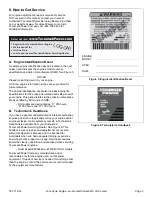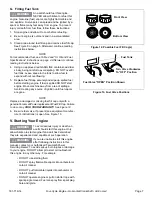
181-719-14
Four-Cycle Engine • Horizontal Crankshaft • Air-Cooled
Page 17
IX. Storing Your Engine
A. Short-Term/Seasonal Storage
I.
Clean Engine
Before servicing the engine remove the carburetor cover
and/or blower housing. Remove grass clippings, dirt and
debris from the following areas:
• Cooling Fins
• Air Intake Screen
• Levers
• Linkage Area
• Guards
• Carburetor
• Head
Removing debris will insure adequate cooling, correct
engine speed and reduce the risk of fire.
II. Fuel Storage
NEVER store engine with fuel in the
fuel tank inside a building with
potential sources of ignition such as hot water or space
heaters, clothes dryers, electric motors, etc. Doing so may
lead to an explosion resulting in death or serious injury.
NOTES
If engine fuel stored in the gas tank and/or an approved gas
container is to be unused without gasoline stabilizer for
more than 15-30 days, prepare it for short-term/seasonal
storage. See "IV. Fuel Treatment" instructions. Afterward,
continue reading instructions below.
If engine fuel is to be stored for more than one season,
without gasoline stabilizer, it will gradually deteriorate. Also,
if it is stored in the engine’s gas tank without gasoline
stabilizer it is likely that your carburetor will have gum
deposits, a clogged fuel system and
WILL VOID YOUR
WARRANTY.
Prepare the fuel for extended storage. See
"B. Extended Storage" instructions. Afterward, continue
reading instructions below.
III. Fuel System
To avoid stale gas and carburetor problems, treat the fuel
system in the following method below:
NOTES
TecumsehPower Company recommends using
ULTRA-FRESH™
Gasoline Stabilizer as an acceptable
method of minimizing formation of fuel gum deposits during
storage. This product is available from your Authorized
TecumsehPower Servicing Dealer.
Always follow mix ratio found on stabilizer container. Failure
to do so may result in equipment damage.
It is NOT necessary to drain stabilized gas from carburetor.
IV. Fuel Treatment
1.
Add fuel stabilizer according to manufacturer’s
instructions.
2.
Run engine at least 10 minutes after adding stabilizer
to allow it to reach carburetor.
NEVER store engine with fuel in the
fuel tank inside a building with
potential sources of ignition such as hot water or space
heaters, clothes dryers, electric motors, etc. Doing so may
lead to an explosion resulting in death or serious injury.
NOTE
Instead of using a fuel preservative/stabilizer, you can
empty the fuel tank as described under "I. Draining Fuel"
instructions.
B. Extended Storage
I.
Draining Fuel
NOTES
Clean debris from engine before draining fuel from
carburetor. See "I. Clean Engine" instructions. Afterward,
continue reading instructions below.
If you have prepared your fuel for short-term storage it is
NOT necessary to drain fuel that contains stabilizer from
your carburetor. See "A. Short-Term/Seasonal Storage"
instructions. Afterward, continue reading instructions below.
To avoid serious injury or death,
DO NOT pour fuel from engine or
siphon fuel by mouth.
1.
To prevent serious injury from fuel fires, empty fuel tank
by running engine until it stops from lack of fuel. DO
NOT attempt to pour fuel from engine.
2.
Run the engine while waiting until the remaining fuel is
consumed.
NEVER leave the engine unattended
when it is running and NEVER run
engine in enclosed areas to avoid death or serious injury.
3.
Begin servicing the cylinder bore. See "II. Oil Cylinder
Bore" instructions on page 18.
NOTE
If you operate the engine during all four seasons, it is not
necessary to lubricate the cylinder bore.
WARNING
WARNING
WARNING
WARNING






































